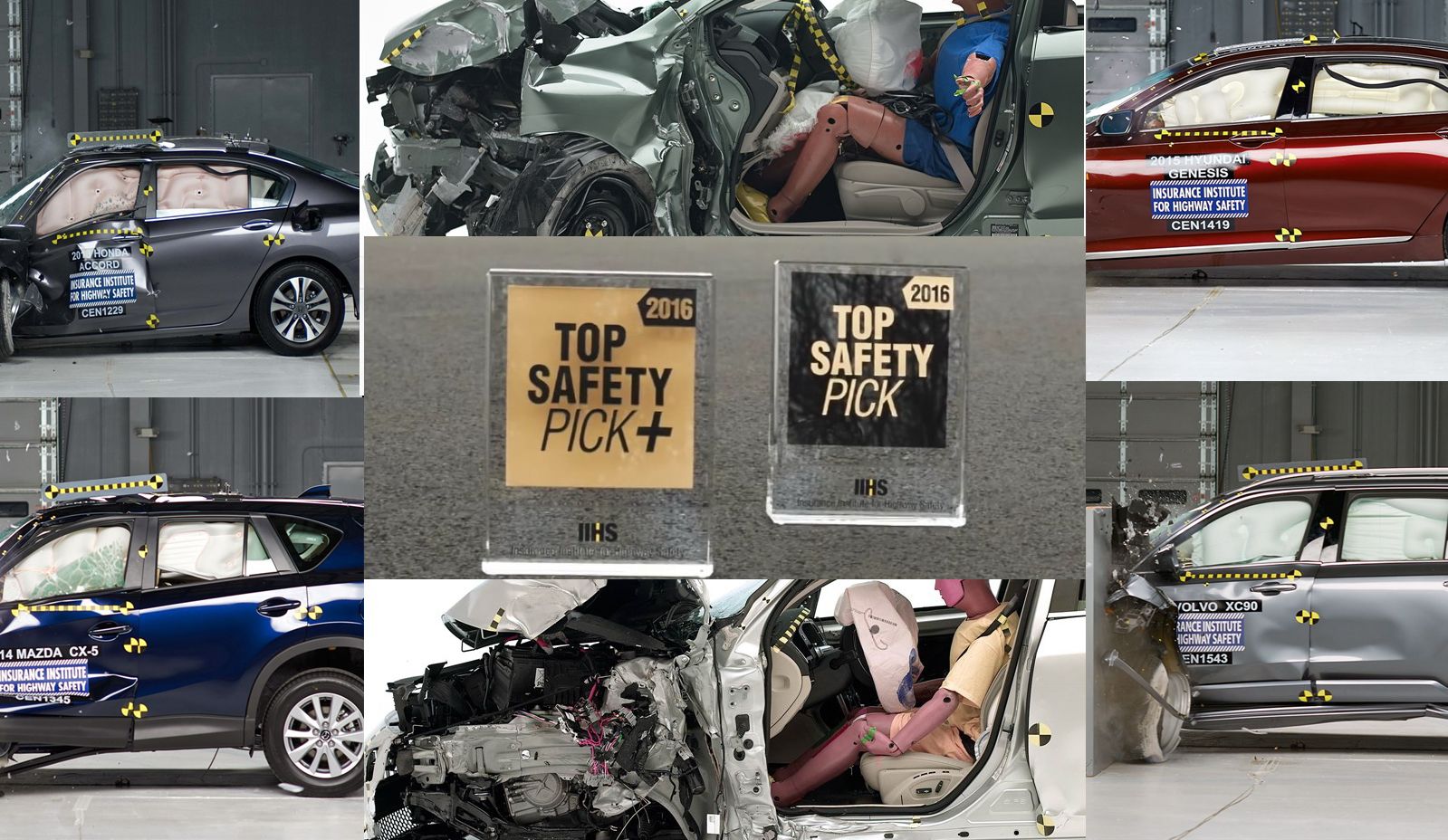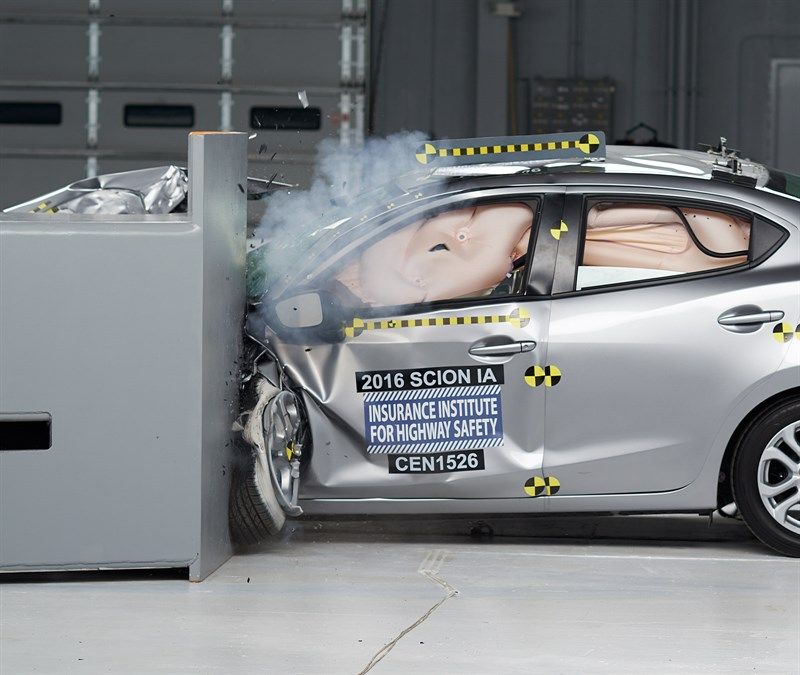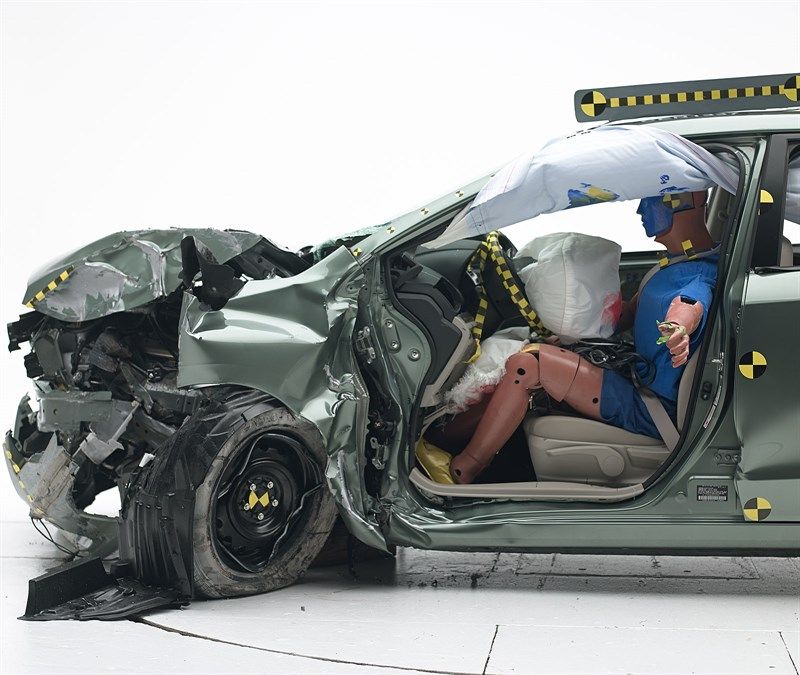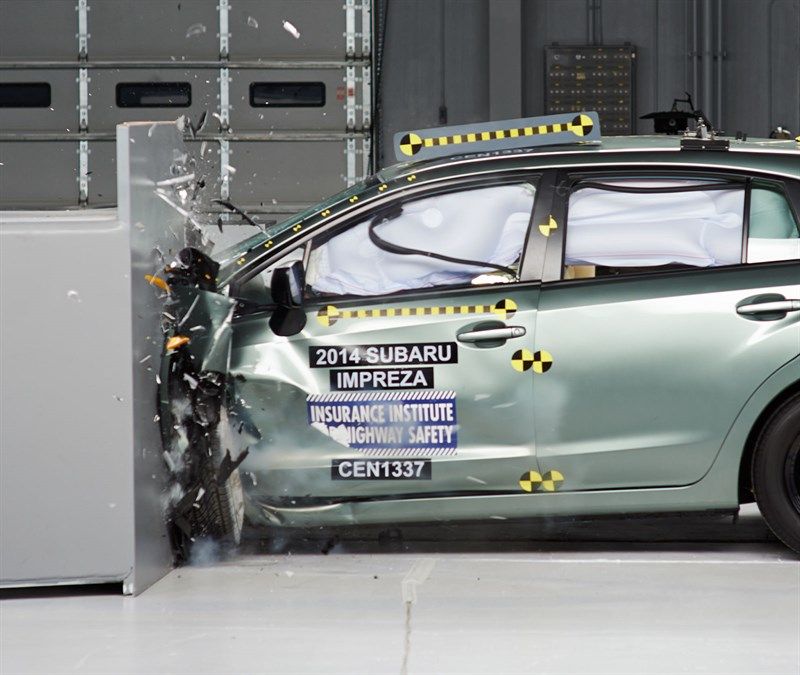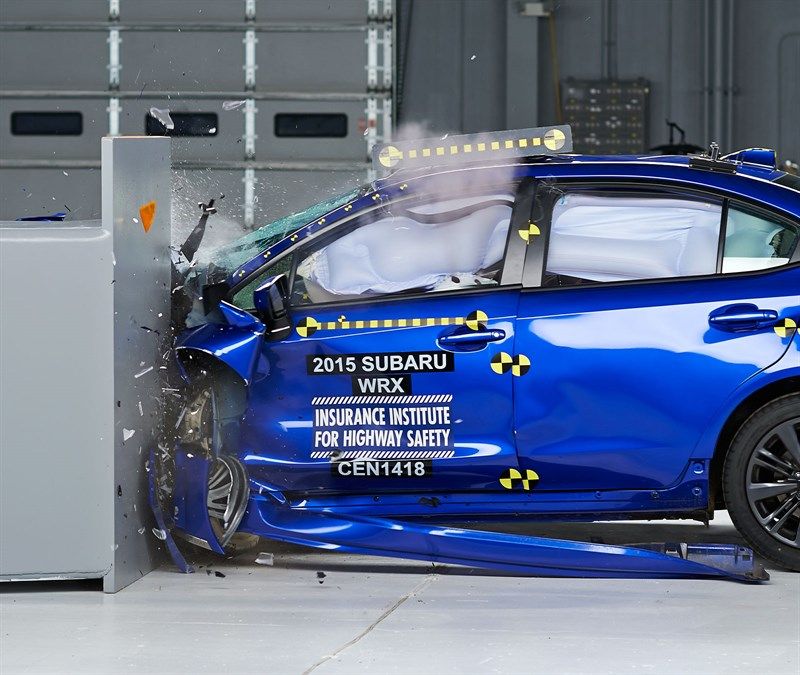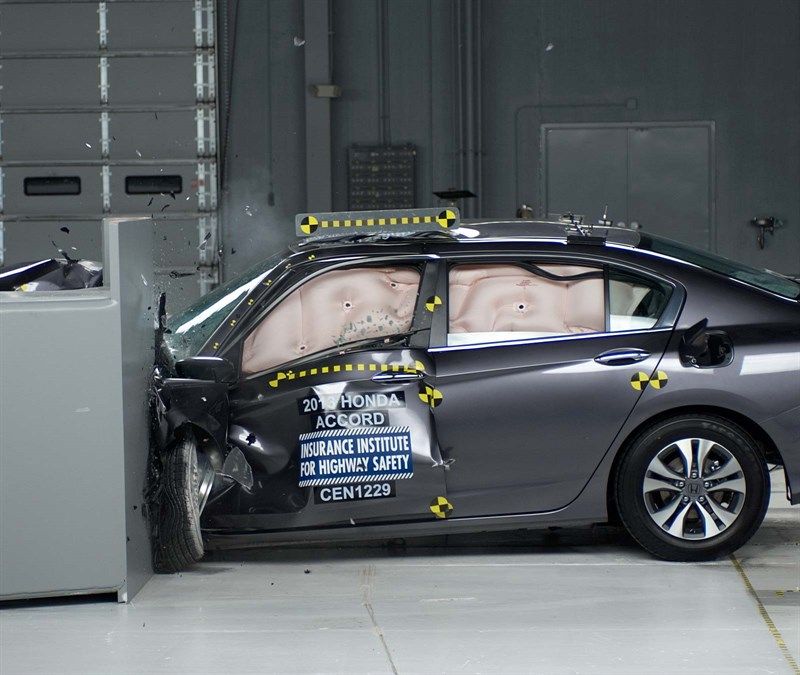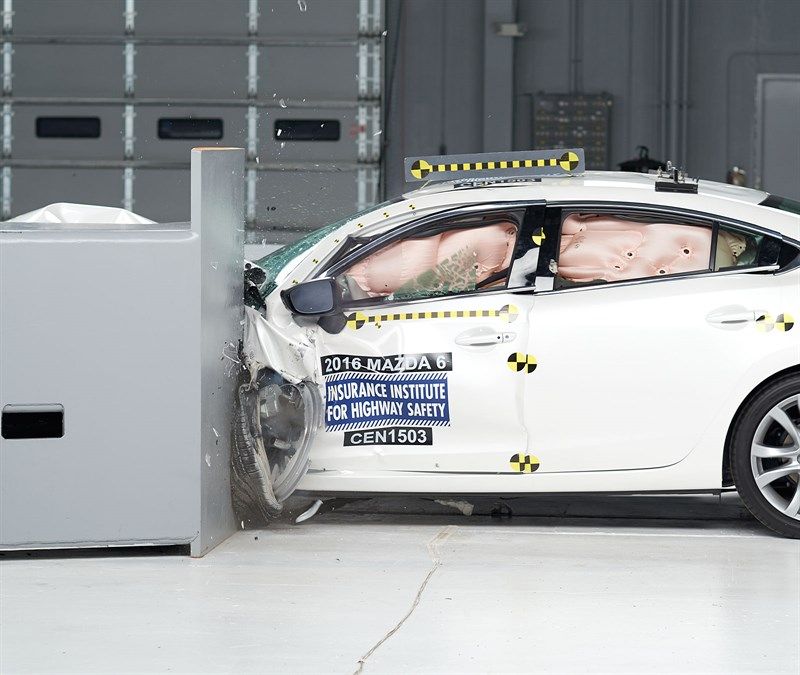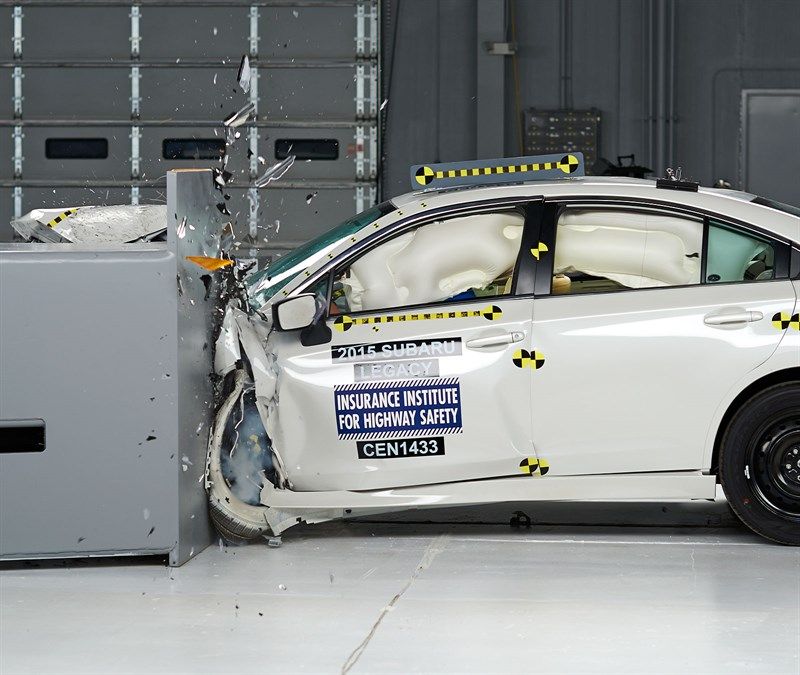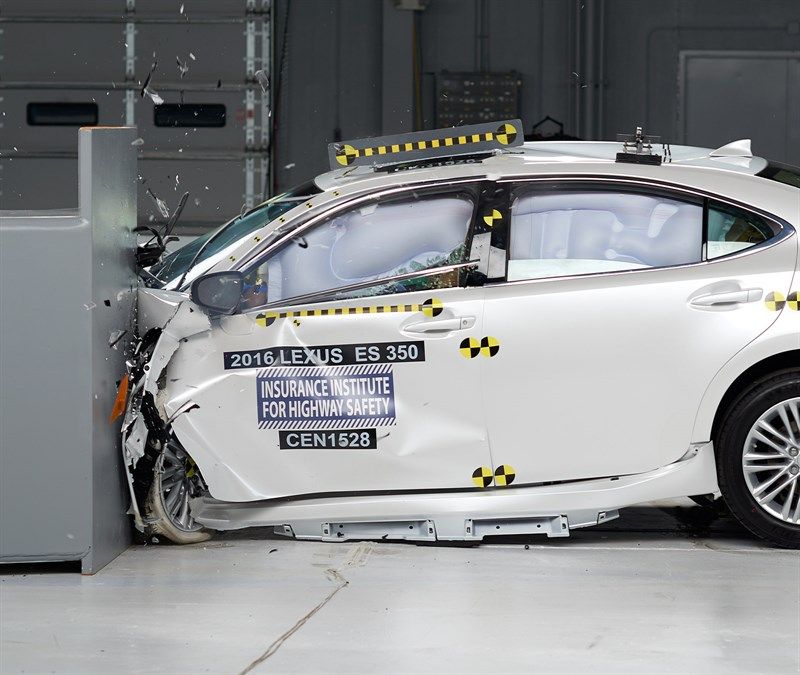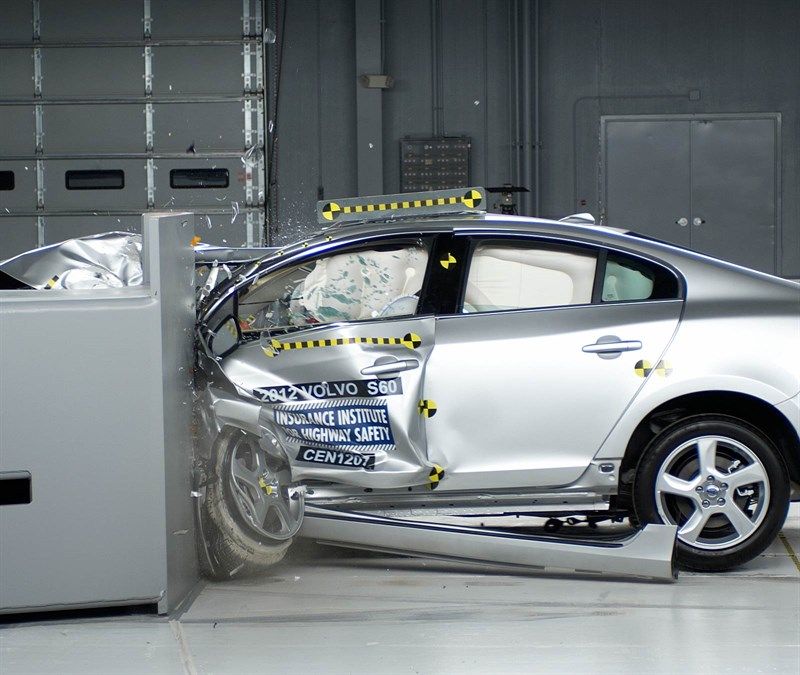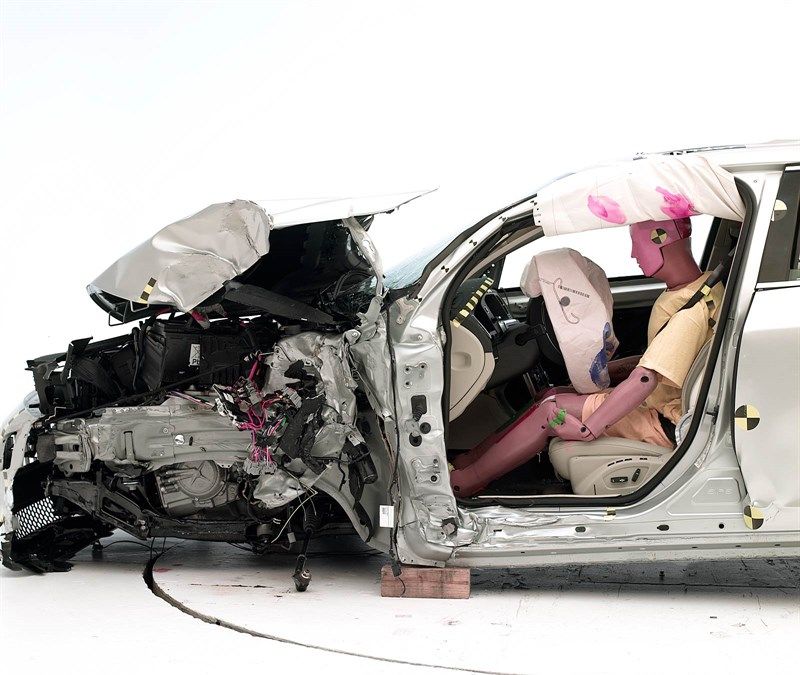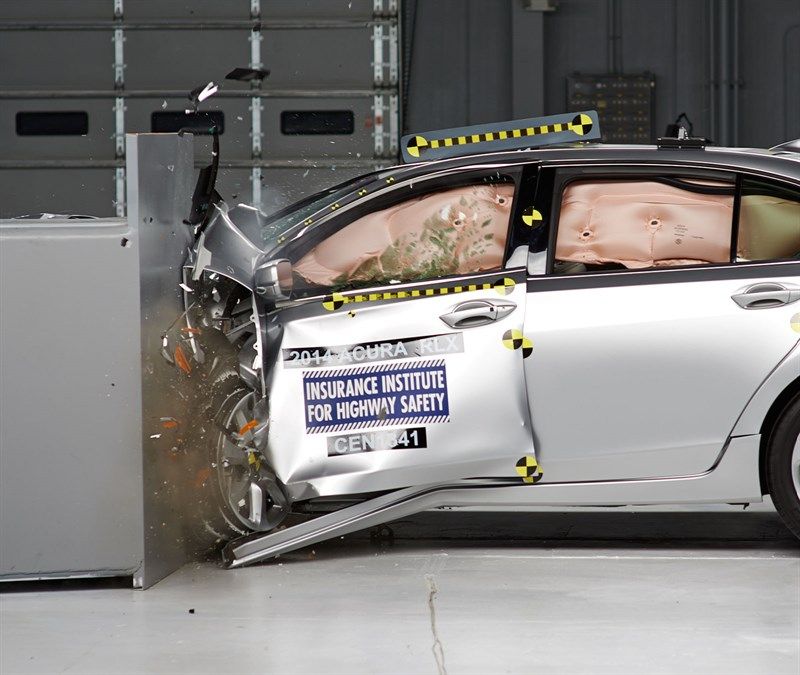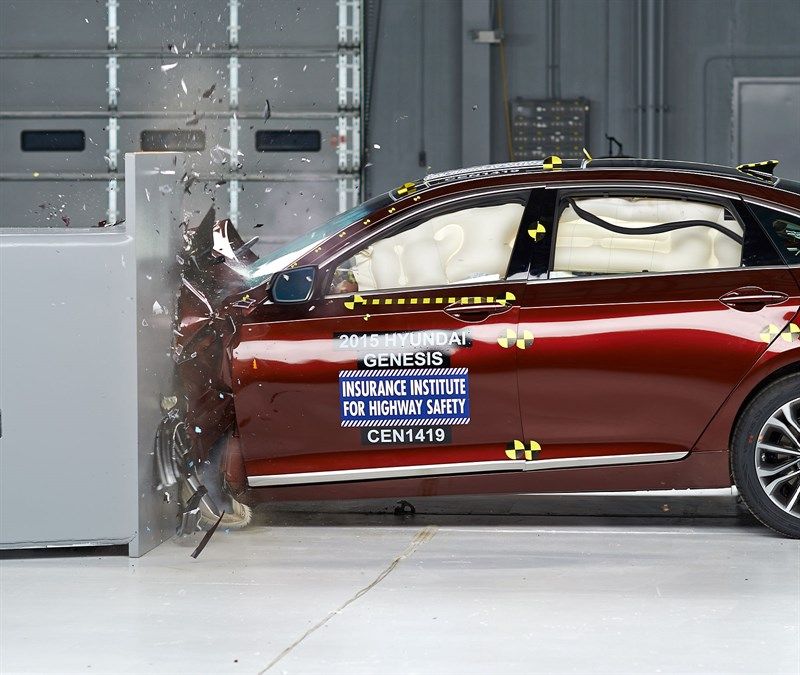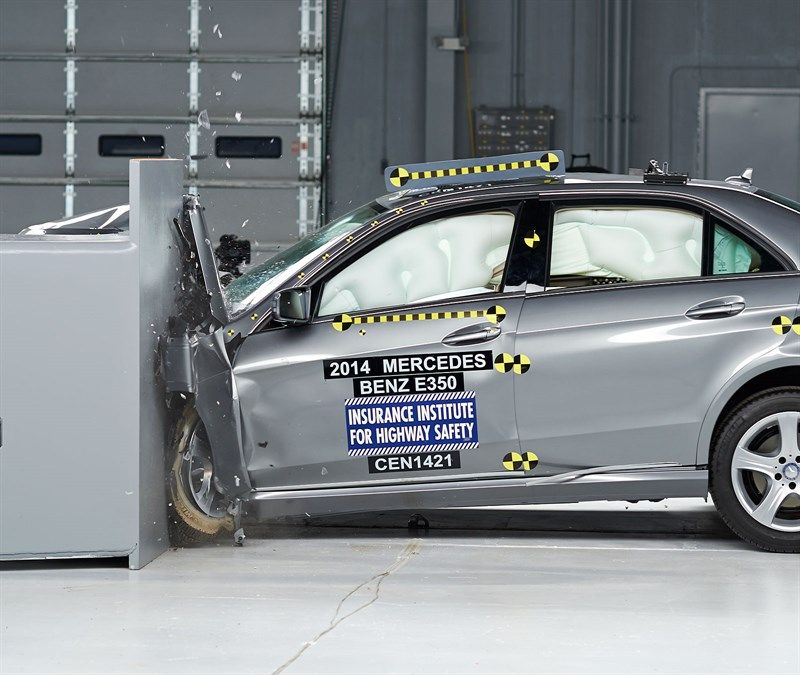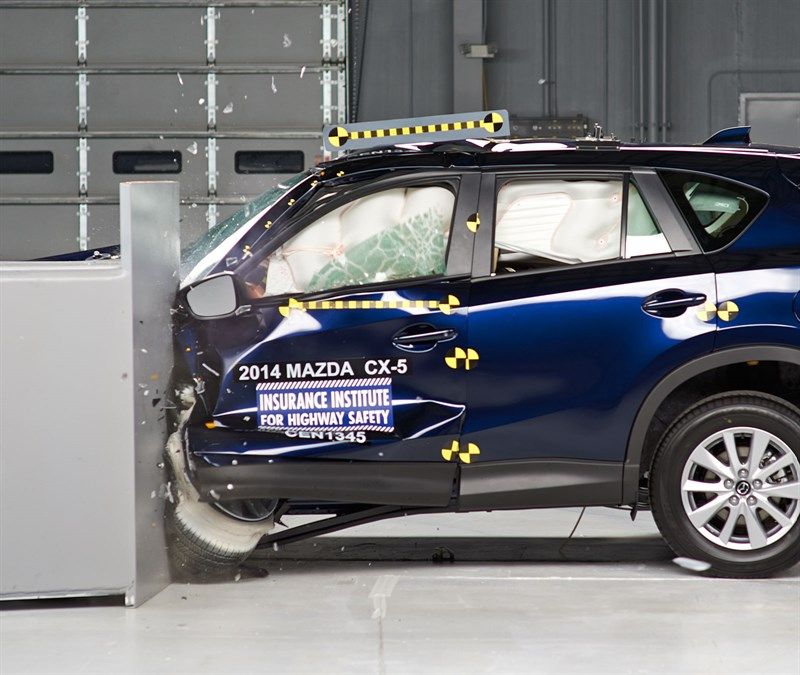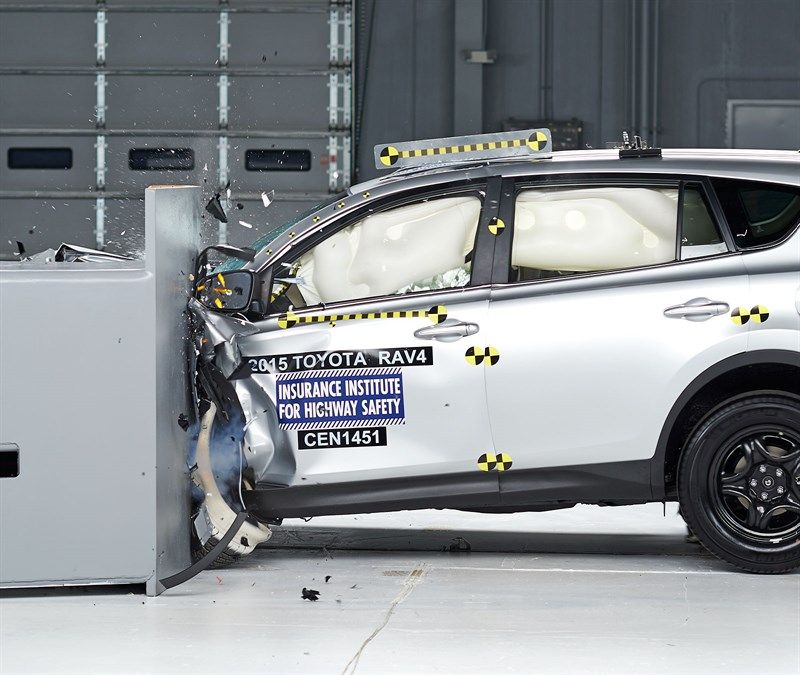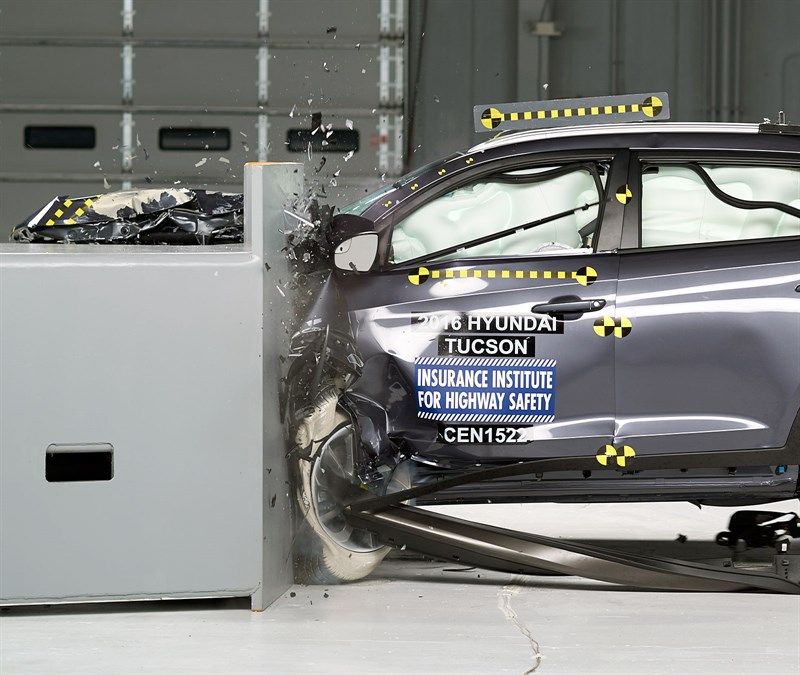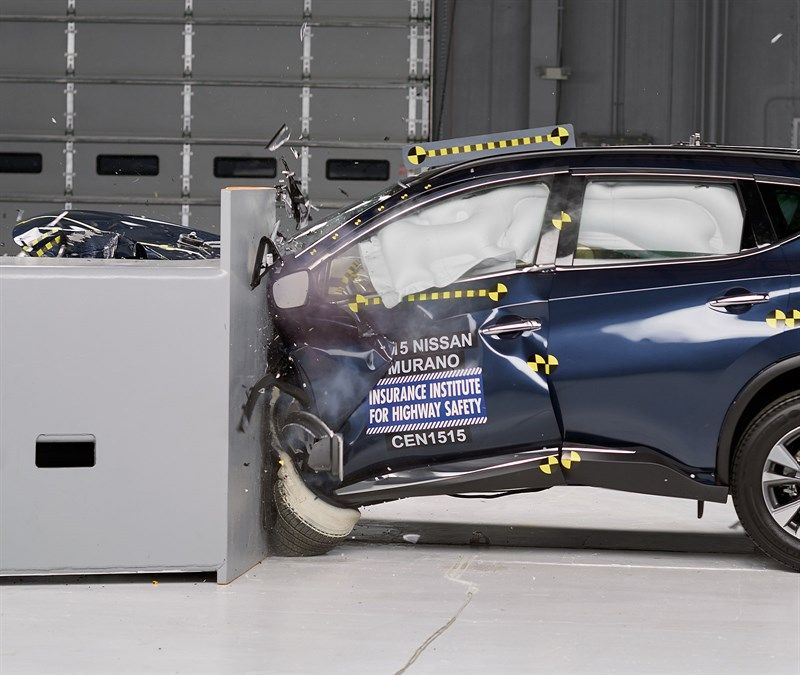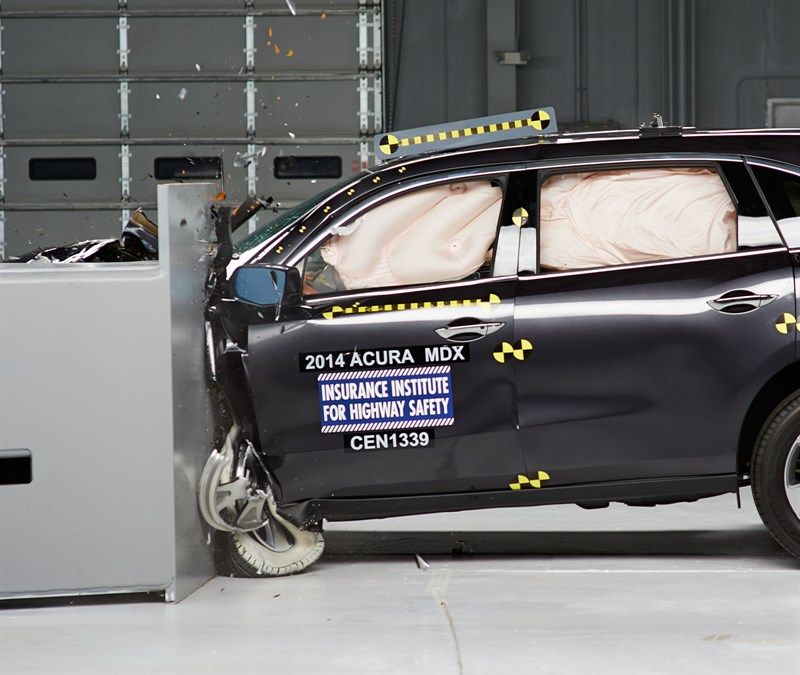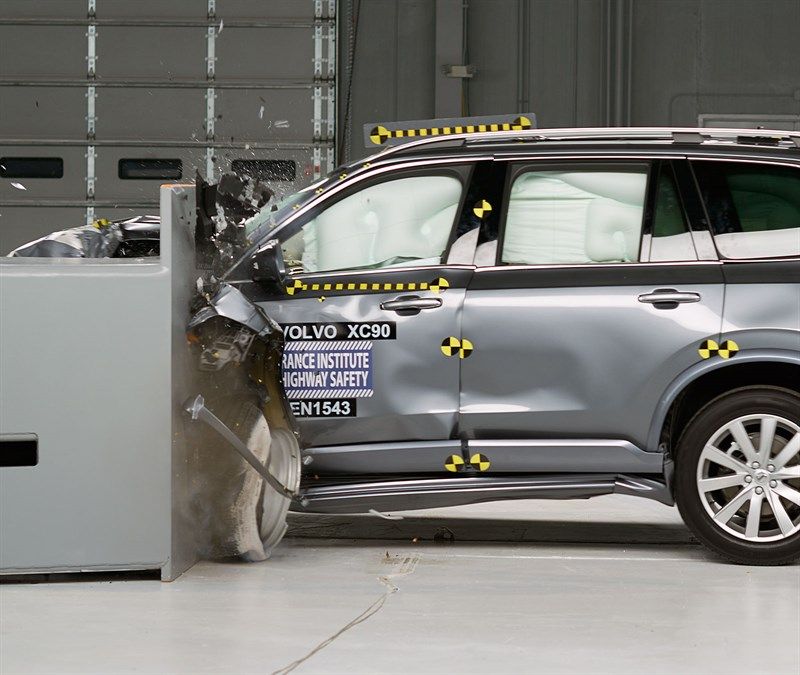Every year, the Insurance Institute for Highway Safety (IIHS) issues awards to vehicle models that meet certain safety->ke2860 criteria. There are two different awards: Top Safety Pick and Top Safety Pick+. To achieve either award, a model must achieve good ratings in five different tests – small frontal overlap, moderate frontal overlap, side crash, roof strength, and head restraint tests. It should be noted that last year, models only had to achieve an “acceptable” rating in the small frontal overlap category to qualify.
Those five ratings aren’t all that a model has to achieve in order to meet the criteria of being in the IIHS’ top safety picks. All models must have some kind of front crash prevention. Models that have all “Good” ratings but only receive a “Basic” rating for front crash prevention are named Top Safety Pick. Models that have all “Good” ratings and have an “Advanced” or “Superior” rating for front crash prevention are given the award for Top Safety Pick+.
For 2016, there is a total of 61 models that have met the IIHS’ criteria for either award, with 48 meeting the criteria for being named a Top Safety Pick+. It might come as a bit of a shock to some, but only one domestic vehicle has been named as a Top Safety Pick+, the 2016 Chrysler 200. All other vehicles on the list are from automakers like Subaru->ke86, Volkswagen,->ke94 Mazda,->ke53 and Hyundai,->ke201 among other others.
It is unfortunate, but as reality has it, car accidents happen. It is important that you take safety ratings into consideration when purchasing a new car, as it could very well mean the difference between life and death. That said, we’ve taken the top three cars that have received a Top Safety Pick+ award from each segment and covered them in detail below. We hope that you’ll take these safety ratings into consideration next time you’re strolling the car lot looking for a new ride, and may every trip you take – long or short – be a safe one.
Sub-Compact Segment
Adrian Lund, the president of the IIHS, says, “Ask for auto brake and forward collision warning features when you’re out shopping for a new vehicle, and remember that larger, heavier vehicles offer the best protection in a crash.” When you take that sentence into consideration, it should come as no surprise that the sub-compact segment didn’t exactly have a long list of Safety Pick+ vehicles. In fact, it only had one….
Scion iA
Scion->ke79 isn’t exactly a new brand, as it has been around since 2002, but it is the newest brand on the list. The iA, on the other hand, falls into the new-for-2016 category. The Scion iA is a sporty little sedan has a 1.5-liter engine that puts out 106 horsepower and 103 pound-feet of torque. Power is sent to the front wheels via a six-speed manual or automatic transmission. In addition to the six standard airbags, the Scion iA is one of a few models that offer pre-collision systems as a standard feature. These active systems include dynamic stability control, traction control, brake assist, electronic brake-force distribution, ABS, and a brake over-ride system. These systems all work together to make the car safer. The low-speed pre-collision system actively monitors the road ahead of you, and can apply the brakes to help prevent or lessen the severity of a collision.
As far as testing goes, during the small frontal overlap test and moderate frontal overlap test, the iA received good ratings across the board – injury measurements for the head/neck, chest, hip/thigh, and lower leg/foot all received a good rating and suggest a low risk of significant injury. For side impact testing, all of the aforementioned measures were rated good across the board for front passengers. For rear passengers, however, pelvis/leg injury measurements came in at an acceptable rating, meaning a fracture of the femur on rear passengers is possible. Roof strength rating came in with a strength to weight ratio of 6.22:1, meaning the roof of the iA can take the force of 15,058 pounds before crushing by more than five inches.
Head restraints and seats performed well, earning a “Good” rating, and the front crash prevention system scored two out of six points. It should be noted that the iA only has a low-speed collision prevention system and no forward collision warning system, so the points possible for high-speed testing and the warning system aren’t applicable on the iA. The iA received an “Advanced” rating from the IIHS for crash prevention testing, and ease of use of child seat anchors is rated marginal. The iA currently starts out at $17,595 before options.
Read our full review of the Scion iA here.
Compact Segment
In the compact segment, a total of nine cars made the Safety Pick+ cut. Of those nine, the safest was the Subaru XV Crosstrek->ke4049, Subaru Impreza->ke1319, and Subaru WRX->ke4657. The only other car on the list that received a superior pre-collision system rating was the 2016 Acura ILX, but it fell just short of the Subaru trio. Other cars from the segment include the 2016 Lexus CT200H with a high acceptable rating, the 2016 Madza3 Sedan and Hatchback (both achieved a mid-acceptable rating), the Volkswagen Golf->ke164 (four-door hatchback and SportWagen models) with a high acceptable rating, and the four-door Volkswagen GTI->ke223 with a high acceptable rating. With that said, let’s take a look at the Subaru trio, and what made them superior to the others.
Subaru XV Crosstrek
Note: 2015 Subaru Crosstrek shown here.
The Subaru XV Crosstrek isn’t new to the Safety Pick+ list. From the 2013 model year forward, the XV Crosstrek has achieved “Good” ratings across the board, and for 2015 and 2016, the car has achieved a high-superior rating for front crash prevention. Standard safety features on the 2016 XV Crosstrek include Vehicle Dynamics Control (similar to stability control), ABS with electronic brake-force distribution, a ring-shaped reinforcement frame that directs impact energy around the passenger cabin, and a seven-airbag system. The pre-collision technology that helped the XV Crosstrek obtain a high-superior pre-collision system rating is available on 2.0i Premium and Limited models as optional equipment.
It should also be noted that the XV Crosstrek uses Subaru’s iconic Boxer engine that sits low in the engine compartment, providing a low center of gravity and allowing the engine to push under the vehicle during a front collision as opposed to into the passenger compartment.
For the 2016 model year, the XV Crosstrek achieved a “Good” rating for the small and moderate frontal overlap tests. Injury measures for these tests indicate that passengers aren’t likely to receive injuries to the head/neck, chest, hip/thigh, or lower leg/foot. Side impact testing indicated injuries to the head/neck, torso, or pelvis/leg are unlikely for front or rear passengers, and head protection was rated “Good” as well.
While these ratings were “Good,” the IIHS gave the XV Crosstrek an “Acceptable” rating for cabin structure on side-impact crash testing, meaning there was some damage to the structural integrity of the passenger cabin, but nothing significant enough to suggest serious injury in the event of a collision. Roof strength came in with a strength-to-weight ratio of 5.2:1, meaning the XV Crosstrek’s roof can take 15,525 pounds of pressure before crushing in by five inches. Seat and head restraint ratings were “Good,” and the XV Crosstrek achieved six out of six points for crash prevention testing. This means the auto brake feature avoided a collision at 12 mph and 25 mph, plus it has a forward collision warning alert. The XV Crosstrek currently starts out at $21,595.
Read our review of the 2015 Subaru Crosstrek here.
Subaru Impreza
The Subaru Impreza->ke1319 returns this year with good ratings across the board for both front overlap tests, side impact, roof strength, head restraints, and seats, achieving a high-superior front crash prevention rating 2016, just as it did for the 2015 model year. Like its cousin the XV Crosstrek, the Impreza has all of Subaru’s best safety equipment, including vehicle dynamics control, ABS, electronic brake-force distribution, and symmetrical all-wheel drive. They Eyesight Driver Assist system, monitors traffic, has lane departure warning, and optimizes cruise control. This system also includes the frontal collision prevention system, which can automatically stop or slow the vehicle when a collision is imminent.
In frontal overlap testing, the Impreza scored “Good” across the board for both small and moderate overlap categories. In these kinds of frontal collisions, injury to the head/neck, chest, hip/thigh, or lower leg/foot of passengers comes at a low risk. Results for side impact testing came in well too, with good ratings for head/neck, torso, pelvis/leg, and head for front and rear passengers. It should be noted that like the XV Crosstrek, structure and safety cage rating came in as “Acceptable.”
Roof strength testing, which applies to 2012 to 2016 model years, indicates the roof can sustain the pressure of 15,525 pounds before crushing more than five inches. Front crash prevention was rated at high-superior, with the Impreza achieving six out of six points for forward collision warning and auto brake functions. At both 12 mph and 25 mph, the Impreza was able to identify a hazard and automatically stop to avoid a collision. Models with available Eyesight Driver Assist Technology start at $22,595, with that option adding $2,895 to the sticker price.
Read our review on the 2015 to 2016 Subaru Impreza here.
Subaru WRX
As you would expect from Subaru,->ke86 the WRX repeats its all “Good” rating for 2016. This year, however, the IIHS tested and graded the WRX for its front crash prevention as well. Like its other siblings on the IIHS’ Safety Pick+ list, the WRX also features the low-sitting Boxer engine, and includes a smart braking system (ABS and EBD) and Subaru’s Symmetrical all-wheel drive. Premium and Limited trim models can be equipped with a Sport Lineatronic transmission that gives the car variable torque distribution that allows the AWD system to respond actively to road conditions. Eyesight Driver Assist is available on WRX Limited models, which includes Subaru’s variation of crash prevention technology.
During IIHS testing, the WRX achieved all “Good” ratings for the small frontal overlap test. In this kind of collision, passengers aren’t likely to sustain an injury to the head/neck, chest, head/thigh, or the lower leg/foot. During the moderate frontal overlap test, on the other hand, the WRX didn’t perform quite as well. Potential for injury to the chest and leg/right foot are minimal, with the car achieving a “Good” rating, however, head/neck and left leg/foot received an “Acceptable” rating. During testing, the test dummy’s head accelerated through the steering wheel airbag and struck the steering wheel, indicating a head injury may be possible in a moderate frontal overlap collision. Forces on the left lower leg also indicated that there may be a potential for injuries in the same collision.
The overall evaluation was still rated as “Good,” but these are important results to be aware of. Side impact ratings are “Good” across the board for both front and rear passengers, meaning the potential for injury to the head/neck, torso, or pelvis/leg are minimal. For the roof, the strength-to-weight ratio comes in at 5.16:1, which means the roof can sustain a peak force of 17,641 pounds before crushing more than five inches. This is over 2,000 pounds more than the other two Subaru’s in this segment. Like the other Subaru’s, when equipped with the Optional EyeSight technology, the WRX scores six out of six points – giving it a “high-superior” rating. The base-model WRX starts out at $26,595, while the WRX STI – the only trim with available EyeSight technology – starts out at $39,995.
Rear our full review on the 2015 - 2016 Subaru WRX here.
Midsize Segment->ke1695
The Midsize->ke1695 auto segment is a very popular segment here in the U.S., and as fate would have it, it is also the segment that has the most Safety Pick+ models. It should also be noted that this is the segment that includes the one domestic model out of the entire list – the Chrysler 200.->ke3341 It achieved the required “Good” ratings across the board and scored five out of six points in the crash prevention testing. It lost one point because during high-speed auto brake testing, the car only slowed 14 mph – significantly reducing the impact, but not preventing it all together. Other models on the list include the 2016 Honda Accord Coupe with a six point superior crash prevention score, the 2016 Nissan Maxima with a five point superior crash prevention score, the Subaru Outback->ke1052 with a six point superior crash prevention score, the Toyota Camry->ke246 with a four point advanced crash prevention score, the Toyota Prius->ke231 V with a three point advanced crash prevention score, the Volkswagen Jetta->ke306 with a two point advanced crash prevention score and the 2016 Volkswagen Passat with a three point advanced crash prevention score. After reviewing the data, we have determined that the 2016 Honda Accord Sedan,, 2016 Mazda 6 and 2016 Subaru Legacy are the safest midsize vehicles on the list, so let’s take a deeper look at their results.
Honda Accord Sedan
For the 2013 through 2015 model years, the Accord Sedan achieved “Good” ratings across the board, but only achieved a single point for front crash prevention, giving it a basic rating. The Accord was heavily refreshed for the 2016 model year, and as part of that refresh, it received a plethora of new technology. That technology actually resulted in the Accord achieving a six-out-of-six score for front crash prevention – a huge improvement over previous years.
During the IIHS’ small and moderate overlap testing, the Accord performed well, protecting test dummies from any significant injury. During the small overlap testing, however, structural integrity was somewhat compromised by an intrusion of up to 17 cm to the lower interior and 12 cm to the upper interior. This gave the Accord an “Acceptable” rating for Structure and safety cage. This level of structure compromise was not observed with moderate overlap testing. Side-impact testing resulted in Good ratings across the board with a low risk of significant injury to any part of the body for front or rear passengers. Roof strength came in with a strength-to-weight ratio of 4.92:1, which means the roof can take a peak force of 15,907 pounds before collapsing by more than five inches. Finally, we get to where the Accord really stands out over the past few model years. The technology that is responsible for the Accord’s crash prevention score of six out of six is known as Honda Sensing.
It comes standard on the Touring trim level, and optional on LX, Sport, and EX trim levels. Honda sensing includes road departure mitigation, lane keeping assist, adaptive cruise control, collision warning, and collision mitigation braking system. During testing, the Accord successfully stopped during both braking tests, preventing a collision at 12 mph and 25 mph automatically. The Accord starts out at $22,105, but adding the Honda Sensing package to models without navigation adds $1,000 to the ticket, while those package with navigation adds $2,000 to the invoice.
Read our full review on the Honda Accord Sedan here.
Mazda 6
The IIHS has tested and rated the Mazda 6->ke346 since 2003, but the 2016 model year is the first year the car has received a “Good” rating across the full spectrum of testing. 2016 is also the first year the Mazda 6 has earned more than two points for front crash prevention.
Testing of the Mazda 6 shows that all passengers, front and rear, are at a low risk of injury during a side collision. Head/neck, torso, pelvis/leg, and head protection all achieve the highest rating. Roof strength testing came in with a “Good” rating as well, as testing indicated the roof can sustain 16,776 pounds of force. With a curb weight of 3,217 pounds, the Mazda 6 has a strength-to-weight ratio of 5.21:1. Overlap crash testing revealed almost all “Good” ratings, except for the lower leg/foot category and dummy kinematics category, which received an “Acceptable” rating. Dummy testing showed that on short overlap testing, injury may occur to the driver’s lower leg and foot. Also, during the testing, the test dummy’s head was restrained by the frontal and side airbags, but it did move toward the A-pillar on impact.
For evaluation of front crash prevention, the Mazda 6 was tested in two different configurations. In one test, the Mazda 6 was tested with only the Smart City Brake Support package, where it earned two out of six points, giving it an advanced crash prevention rating. In this configuration, the car is void of any forward collision warning system. At 12 mph, the car effectively avoided a collision automatically, but at 25 mph the system failed to apply the brakes. When tested with the Touring Technology Package and Smart City packages, the car scored all six points, stopping automatically in 12 mph and 25 mph tests. With the Touring Technology package, the car also has a forward collision warning system.
In sport trim, advanced safety features are limited to dynamic stability control and a traction control system. Moving up to the Mazda 6 Touring brings a blind spot monitoring system and rear cross-traffic alert. Moving up to the Grand Touring trim, which is by far the safest trim level, adds on Smart City Brake Support. These trim levels are priced at $21,495, $23,945, and $30,195, respectively.
Read our full review of the 2016 Mazda 6 here.
Subaru Legacy
Subaru advertises how safe its vehicles are, so it is no surprise that they have more than one vehicle in the midsize segment as well. The legacy->ke1402 has been evaluated by the IIHS in one capacity or another since 1995, and it has been rated as superior for front crash prevention 2013. Just like last year, the Legacy achieved an overall “Good” rating for all test categories.
So far, most of the models on our list have had at least one “Acceptable” rating, normally in the small overlap portion of testing. That, however, isn’t the case for the Legacy. It, like the other models in Subaru’s lineup, has a ring-shaped reinforcement frame and a total eight airbags as standard equipment. Other standard safety equipment includes a smart braking system (ABS and EBD), stability control, and symmetrical all-wheel drive. Eyesight Driver Assist, blind-spot detection, and rear cross-traffic alert are available on the 2.5i Premium, 2.5i Limited, and 3.6R Limited trim levels. Thanks to all of these safety systems, testing shows that the risk of injury to passengers in small and moderate overlap collisions, and side collisions is minimal. The roof of the Legacy was found to take 18,533 pounds of force without crushing inward by more than five inches. At a curb weight of 3,455 pounds, the Legacy earned a strength-to-weight ratio of 5.36:1.
In models equipped with the aforementioned optional safety technology, the Legacy successfully avoided collisions by automatically braking from 12 and 25 mph, and offered a collision warning. The Eyesight safety system adds on a $1,195 premium to the 2.5i Premium trim. 2.5i and 3.6R Limited trims come standard with blind spot detection, but you’ll pay an extra $3090 to get Eyesight technology on either. That $3090 also includes a moonroof, keyless entry, push-button start, and a navigation system. The 2.5i Premium starts out at $23,845; the 2.5i Limited asks $26,845; and the 3.6R Limited commands $29,945 – all before options.
Read our full review on the 2015 - 2016 Subaru Legacy here.
Midsize Luxury Segment
In the midsize luxury->ke505 segment, only five models made their way to the Safety Pick+ list. The three safest were the Lexus ES,->ke280 Volvo S60,->ke413 and Volvo V60->ke3667 – all three achieved “Good” overall ratings across the board, and “Superior” ratings for their crash prevention technology. The runners up – the Audi A3->ke1086 and BMW 2 Series->ke2065 – also received “Good” overall ratings. The Audi A3 received a rating of “Advanced,” scoring three out of six points for its crash prevention technology. The BMW 2 series also received an “Advanced” rating for its crash prevention technology, scoring a total of four out of six points. With that said, let’s take a look at the three safest models of the segment, and see why they achieved “Superior” ratings over the others.
Lexus ES350
The Lexus ES came to be for the 1990 model year as the ES 250, which was little more than a Toyota Camry->ke246 with a big “L” badge on the front and rear. The ES continued to be based on the Camry for 12 years, but in 2007 the ES350 debuted. As far as safety goes, the ES350 has had a turbulent life. From 2007 to 2012, the car received “Poor” ratings from the IIHS in small frontal overlap testing. During the same six-year period, it also received a “Marginal” rating for head restraints and seats. From 2013 to 2015, the ES350 wasn’t tested for small frontal overlap collisions, but during that time, the rating for head restraints and seats moved from “Marginal” to “Good.” For the 2015 model year, the ES350 went through a refresh, and this time, Lexus->ke47 got everything right.
During small frontal overlap testing, the ES350 achieved an overall “Good” rating. Injury measures for head/neck, chest, and hip/thigh were all rated “Good.” Lower leg/ foot, however, received an “Acceptable” rating – only because test dummy measurements indicate that injuries to the right, lower leg could be possible in a small frontal overlap collision. During moderate frontal overlap testing, the ES350 scored “Good” across the board, indicating injury to a passenger’s head/neck, chest, and both legs/feet aren’t likely. In side impact testing, test dummy reactions indicate that both front and rear passengers should be safe, with all categories – head/neck, torso, pelvis/leg, and head protection – all achieving “Good” ratings. During roof strength testing, the ES350 was found to be capable of sustaining 18,556 pounds of force before the roof collapses by more than five inches.
The ES350 is the heaviest of the cars we’ve reviewed so far at 3,558 pounds, but sustaining more than 18,000 pounds of force gave the car a roof strength-to-weight ratio of 5.22:1. When optioned with the Lexus Safety System+ package, the ES350 comes equipped with a pre-collision system (with pedestrian detection,) dynamic radar cruise control, lane departure alert with steering assist, and intelligent high-beam headlamps. This package allowed the ES350 to achieve six out of six points for pre-collision system testing. It should be noted that this package adds to a long list of standard safety features on the ES350, and comes at a premium of $500, or $1,015 with bi-LED headlamps.
Read our full review on the 2016 Lexus ES here.
Volvo S60
Since the 2011 model year, the S60 has achieved a rating of “Good” across the board from the IIHS for both overlap tests, side collision tests, roof strength, head restraints, and seats. From 2013 on, the ES350 has achieved a “Superior” rating for front crash prevention, scoring five out of six points each year when equipped with optional equipment. Volvo already has the correct mix for the S60, and those results have remained unchanged for the 2016 model year.
During small and moderate frontal overlap testing, the S60 achieved “Good” ratings for safety to the head/neck, chest, hip/thigh, and lower leg/foot. It should be noted, that during small frontal overlap testing, the test dummy’s head slid to the left on the airbag and into a gap between the front and side airbag – leaving the potential for contact with the forward side of the vehicle or outside objects. This led to an “Acceptable” rating for restraints and dummy kinematics. Side impact testing showed there is a low risk of injury to the front or rear passengers, with protection for head/neck, torso, pelvis/leg, and head protection all achieving a “Good” rating. Roof strength testing proved a strength-to-weight ratio of 4.95:1, which is well above the “Good” line set by the IIHS at 4.00:1. The S60’s roof can take peak force of 17,650 pounds before crushing in by more than five inches. In the crash prevention testing, the S60 achieved five out of six points.
The car comes standard with Intellisafe, which includes a frontal collision warning system and automatic braking – leading to the “Superior” crash prevention rating. The S60 lost one point during the 25 mph testing, as the auto braking system only slowed the car by 14 mph as opposed to completely stopping it. Even still, that pedestrian on the road will be a lot better off being hit at 11 mph as opposed to 25 mph. The S60 starts out at $33,950, and an optional Blind Spot Information System comes at a premium of $925. That package includes blind spot notification, cross traffic alert, front and rear park assist, and lane change merge aid, which was also factored into the “Superior” crash prevention rating.
Read our full review on the 2016 Volvo S60 Inscription here.
Volvo V60
The Volvo V60 is basically the S60 in wagon form. It has been sold to our European brethren since 2013, but didn’t hit U.S. shores until 2015. Now in its second year in the U.S., the V60 has achieved good overall ratings across the board, with a superior crash prevention rating for both years it has been tested by the IIHS. For 2016, the V60 comes standard with the same Intellisafe system as it’s slimmer brother, the S60.
The V60 obtained the same ratings as the S60 for small and moderate frontal overlap collisions. The possibility of significant injury for the head/neck, chest, hip/thigh, or lower leg/foot is low. Considering the front end of the V60 is identical to the S60, it is no surprise that the test dummy’s head slid between the side and front airbags on the V60 as well. This, of course, led to an “Acceptable” rating for restraints and dummy kinematics, but that wasn’t enough to drop the overall rating of the V60. In side-collision testing, both front and rear dummies indicate a low risk of injury to any part of the body, thanks to the side curtain airbag. Roof strength came in with a strength-to-weight ratio of 4.95:1, with the roof needing a force of 17,650 to crush in by five inches.
With the standard Intellisafe safety package only, the V60 scored only two out of six points, as there was no forward collision warning. In this configuration, the car failed the high-speed auto brake test, with the car only slowing by two mph before impact. With the optional $925 Blind Spot Information System, that score jumps up to five out of six points. The BLIS system adds the forward collision warning, and during the high-speed auto brake testing, the V60 slowed down by 16 mph before impact – making the speed of impact a mere nine mph. Like the S60, the base model V60 starts out a $35,950. Make sure you opt for the BLIS system, though, for added safety.
Read our full review of the 2015 Volvo V60 here.
Large Luxury Segment
The Large luxury segment is home to models like the 2016 Audi A6, Acura RLX,->ke4673 and Volvo S80.->ke394 In this segment, a total of six models made it onto the Safety Pick+ list. The safest of the three are the Acura RLX, Hyundai Genesis,->ke2924 and Mercedes E-Class.->ke373 The Volvo S80 came in a close fourth, obtaining all “Good” ratings and a “Superior” rating for crash prevention, while scoring five out of six points. The S80 only reduced speed to 12 mph before impact during the 25 mph auto brake test, which led to the IIHS docking one point for its overall evaluation for crash prevention. The Lexus RC->ke4751 obtained an "Advanced" crash prevention rating with two points docked for performance during the 25 mph auto brake test. During that test, impact speed was only reduced by eight mph, leading to a speed of 17 mph on impact. For the 12 mph auto brake test, no points were docked, but the impact still occurred. IIHS noted that the vehicle “nearly avoided a collision,” so It is likely that it was a minor impact. Finally, we get to the Audi A6, which performed well outside of the crash prevention test. The A6 only received three points for crash prevention testing, with three points docked for high-speed auto brake testing. On the 25 mph test, speed was only reduced by one mph, while, on the 12 mph test, impact speed was reduced to just two mph – earning the A6 and advanced rating for this category. Now it is time to take a look at the three safest large luxury vehicles.
Acura RLX
The Acura RLX is a relatively new model that first debuted in production form at the 2012 L.A. Auto Show and went on sale in early 2013 as a replacement for the Acura RL. In its short lifespan, the RLX has been evaluated by the IIHS three times and awarded it “Good” ratings across the board each time. For 2014 and 2015, the RLX achieved three out of six points for crash prevention, earning it an advanced rating for that category. For the 2016 model year, Acura stepped its game up even more, earning it the right to say it is one of the safest luxury sedans on the road.
Both overlap collision tests yielded almost all excellent results, indicating that in this type of frontal collision, the driver is at low risk of a serious head, chest, hip/thigh, or lower leg/foot injury. During the Moderate overlap test, there was some pressure imposed on the test dummy’s right leg, indicating that under certain circumstances injury to that leg or foot could be possible. During side-collision testing, it was found that both front and rear passengers were well protected with little risk of significant injury. As to be expected with larger cars, roof strength testing came in the highest we’ve seen on the list so far. The RLX sustained a peak force of 20,314 pounds to the roof before it crumbled inward by five inches, giving it a strength-to-weight ratio of 5.18:1.
It should be noted that even at the five-inch crumble threshold, the strength-to-weight ratio was still at 4.13:1, which is still above the 4.0:1 ratio threshold that separates the IIHS’ “Acceptable” and “Good” rating. When it came to crash prevention systems, the RLX passed with flying colors, stopping automatically to avoid a collision at 12 mph and 25 mph with advanced warning. The RLX is one of three models on the entire list, outside of the Volvo brand, that included collision mitigation braking, and forward collision warning as standard features. These systems, along with ABS and vehicle stability, come standard on all trim levels. The RLX starts out at $54,450 for the base model, moves up to $60,450. All-wheel drive models start out at $59,950, with the top end model hitting the bank for $65,950.
Read our full review on the 2014 Acura RLX here.
Hyundai Genesis
The Hyundai Genesis debuted for the 2008 model year and is now in its second generation. Despite its short history in the market, the Genesis is no stranger to the IIHS’ safety testing. From 2010 to 2014, the Genesis received “Good” ratings from the IIHS for moderate overlap testing, side impact testing, roof strength, head restraint and seats. For the 2015 model year, the Genesis also received a “Superior” rating for front crash prevention. It returns with a “Superior” rating for 2016, and is within the top three safest vehicles in the segment. Let’s take a look at the results in detail.
During testing, the Hyundai Genesis achieved “Good” results across the board for moderate and small overlap testing. In this type of collision, at 40 mph, it was shown that no significant damage would occur to the driver’s head/neck, chest, or either leg/foot. During side-impact testing, it was found that front and rear passengers were at little risk for any significant damage to any region of the body. Like other heavier models in the large luxury category, roof strength came in strong, taking a peak force of 21,387 pounds before the roof was crushed by more five inches. On this model, peak force was actually obtained with the roof crushed inward by 4.6 inches, which is well above the average three inches that we’ve seen with the previous models we’ve reviewed from the Safety Pick+ list. During collision prevention testing, the Genesis was awarded six out of six points, effectively warning of a forward collision, and avoiding a collision automatically at 12 and 25 mph. It should be noted that the model tested was a 2015 model, but the IIHS has determined it is entirely representative of 2016 models. At the dealership, you’ll find that the Genesis sedan is offered in two trims: the 3.8 and 5.0 Ultimate.
On the 5.0 Ultimate, auto emergency braking, smart cruise control, front and rear park assist (with cross-traffic alert), lane departure warning, lane keep assist, blind spot detection, and a haptic steering wheel are all included as standard equipment. If you go with the base model, standard features are limited to ABS with EBD and a nine airbag system. All other safety features are optional. To obtain blind spot detection and rear cross-traffic alert, you must opt for the 3.8 Signature package. To obtain the rest of the aforementioned safety systems, you must opt for the Signature package and the 3.8 Tech Package. The packages come at a premium of $3,900 and $3,500, respectively. The base-model Genesis starts out at $38,750, and obtaining the two optional packages will bring the ticket price up to $46,150. The 5.0 Ultimate trim starts out at $53,850. Like most of the other models on the Safety Pick+ list (with the exception of the Volvo brand) the Genesis only achieved its high safety rating from IIHS with the optional safety features equipped.
Read our full review of the 2015 - 2016 Hyundai Genesis here.
Mercedes E-Class
The Mercedes E-Class has achieved a “Good” rating for moderate overlap testing since the 2000 model year, but it didn’t achieve that rating for side impact, roof strength, head restraints, or seats until the 2010 model year. Starting with 2014, the E-Class has received “Good” ratings across the board – including small overlap testing – and a “Superior” rating for front crash prevention. That said, it is no surprise that the E-Class has obtained the same high ratings for the 2016 model year.
When it comes to the E-Class, the results are a little mixed. For all 2010 to 2016 models, moderate overlap testing suggests little risk of significant injury to any region of the driver – including both legs and feet. Small overlap testing results only apply to models built after January of 2014 and indicate that in this type of collision the driver’s head/neck, chest, and hip/thigh would be adequately protected. It was found, however, that there is a risk of injuries to the driver’s lower legs and feet – earning the E-Class an “Acceptable” rating for the lower legs and feet. It should also be noted that an “Acceptable” rating was given to restraints as well during the small overlap test. During the collision, the test dummy’s head was mostly protected by the front and side curtain airbag, but it still struck the A-pillar. This was the result of the seat belt allowing excessive movement of the head and torso during small overlap collision testing. Both front and rear passengers are at low risk for significant injuries in side impact testing. Roof strength testing came in superior to other models so far, with peak force coming in at 20,961 pounds before the roof crushed in by more than five inches.
Like the 2014 and 2015 model year, the E-Class achieved a “Superior” rating for front crash prevention. When equipped with optional equipment, the E-class was able to brake automatically and prevent a front collision at 12 and 25 mph. When tested without the optional driver assist package, the E-class achieved only five out of six points for crash prevention, with the E-class slowing to four mph before the collision on the 25 mph auto brake test. The E-class model used for IIHS testing was the Mercedes E350, which starts out at $54,025. Adding on the driver assistance package will set you back $2,800 and includes steering assist, cross-traffic assist, pre-safe brake with pedestrian recognition, active blind spot assist, and active lane keep assist.
Rear our review of the upcoming 2017 Mercedes E-Class here.
Small SUV Segment
A total of seven small SUVs made it onto the IIHS’ Safety Pick+ list. Of those seven, the three safest include the 2016 Mazda CX-5, 2016 Hyundai Tucson, and the 2016 Toyota RAV4. Runners up included the Subaru Forrester->ke1151 with all good ratings and a “Superior” crash prevention rating, the 2016 Fiat 500X (built after July 2015) with an advanced crash prevention rating, the 2016 Mitsubishi Outlander with three out of six points for an advanced crash prevention rating, and the Honda CR-V->ke1595 with a Superior rating and score of five out of six points. It should be noted that the Subaru Forrester – like the CX-5, Tucson, and RAV4 – achieved six out of six points for crash prevention. I chose to detail the other three models over the Forrester because it has the same safety and crash prevention technology of other Subaru’s detailed in this publication. As far as the IIHS is concerned, the Forrester is just as safe as the three models detailed below.
Mazda CX-5
The CX-5 has been rated by the IIHS since the 2013 model year, but that inaugural year didn’t yield results as good as the ones that followed. 2013 models were found to have “Good” ratings for moderate overlap collisions, side impact, roof strength, head restraints and seats, but the CX-5 received a “Moderate” rating for small overlap testing. The marginal rating was due to excessive head movement, with a delay in the deployment of the side curtain airbag – ultimately leaving the head vulnerable to contact with the forward side structure. Mazda has since corrected this issue, and from 2014 on, the CX-5 achieved a “Good” rating for small overlap collisions as well. It should be noted that for 2014 and 2015, the CX-5 only scored two out of six points for crash prevention. For 2016, however, Mazda stepped up its game in that category with new technology – leading to a much higher score for crash prevention.
During overlap testing for 2016, the CX-5 showed low risk for injury to any significant portion of the driver’s body. It should be noted, however, that the IIHS gave the CX-5 an “Acceptable” rating for structure and safety cage in small overlap testing. Driver space was maintained fairly well during testing, but during the small overlap test, there was an intrusion into the upper and lower interior by about eight cm. Side impact testing showed that the side curtain airbag deployed correctly, and both front and rear passengers were well protected. The CX-5 earned a “Good" rating for roof strength as well, taking 18,209 pounds of peak force before crushing inward by five inches. With a curb weight of 3,330 pounds, the CX-5 has a roof strength-to-weight ratio of 5.47:1. During testing of the CX-5’s crash prevention system, the CX-5 stopped automatically during the 12 mph test, while it slowed down to just three mph during the 25 mph auto brake test. This performance, in conjunction with a forward collision warning system, earned the CX-5 six out of six points – a “Superior” rating for crash prevention. It should be noted that all safety features aside, from ABS with electronic brake-force distribution, brake assist, and dynamic stability control are optional features that must be purchased as a package.
Furthermore, those options are only available on Touring (starts at $25,215) and Grand Touring (starts at $28,220) trim levels. On Touring models, the Touring Tech package will provide Smart City Braking at a premium of $1,625. To obtain radar cruise control, lane departure warning, distance recognition system and high-beam control, you must move up to the Grand Touring package and opt for the $1,500 I-Active Sense package. The Grand Touring Tech package will grant you Smart City Braking at a $1,505 premium, but to have forward collision warning, you must choose both packages, raising the $28,220 starting price up to $31,225. When equipped with both packages, the CX-5 earned six out of six points for crash prevention – stopping automatically during 12 and 25 mph auto brake tests.
Read our full review on the 2016 Mazda CX-5 here.
Toyota RAV4
Since being released in 1996, the RAV4 has been redesigned four times, with the fourth generation coming to be in 2013. The first two years of its fourth generation were a little rough as far as IIHS testing goes. It achieved “Good” ratings for moderate overlap tests, side impact tests, roof strength, head restraint and seats. These ratings, however, were negatively overshadowed by a “Poor” rating for small overlap testing. This rating was given due to the excessive intrusion of the driver’s space, leading to high risk of injury to the driver’s lower legs and feet. Toyota has since corrected this problem, and for the 2016 model year, the RAV4 achieved “Good” ratings across the board.
For the 2016 model year, the RAV4 earned “Good” ratings for small and moderate overlap collision safety. Neither test suggested any serious risk to the driver in either type of collision at 40 mph. Side impact testing yielded the same result for both front and rear passengers, with the airbags working correctly to protect the head and body of all passengers. Roof strength testing came in with a strength-to-weight ratio of 5.00:1, with the RAV4 taking 17,575 pounds of peak force before exceeding the fivee-inch crush threshold. Safety systems included as standard equipment across the RAV4 line include vehicle stability control, traction control, ABS with electronic brake-force distribution, and smart stop technology.
Blind spot monitoring, rear cross-traffic alert and lane departure alert are only available on Limited models as part of an optional package. The base model starts out at $23,680, but to have the three optional safety features, you must step up to the $28,450 limited trim and opt for the $1,510 JBL audio and technology package. When equipped with these optional safety systems, the RAV4 scores six out of six points for a “Superior” crash prevention rating – passing both 12 mph and 25 mph auto brake tests by avoiding a collision. 2016 is the first year that the RAV4 has been given any crash prevention rating by the IIHS.
Read our full review of the 2015 Toyota RAV4 here.
Hyundai Tucson
The Hyundai Tucson is the smallest, and cheapest of Hyundai’s SUV/crossover lineup. Sales-wise, the Tucson performed poorly for the last of its second-generation years, but for 2016, Hyundai released a new design that is more stylish and safer than previous generations. From the beginning of the second generation in 2010, all the way through the 2015 model year, the Tucson earned good overall ratings for all IIHS test areas except small overlap testing. In that category, the Tucson failed miserably – receiving a “Poor” rating. That rating was given because, during testing, the side airbag failed to deploy, the seat belt failed to restrain the head and torso, and the test dummy’s head ended up striking the instrument cluster as a result. For the 2016 model year, however, Hyundai made huge improvements, earning to Tucson a place on the Safety Pick+ list. It should also be noted that the Tucson also performed admirably well during European NCAP testing, and was found to be well improved all around with an emphasis on improvement of safety assist systems.
The IIHS testing proved on par with Euro NCAP testing, giving the Tucson “Good” ratings across the board. In both overlap tests, the Tucson passed with flying colors. As opposed to previous years, the side airbags deployed as designed, effectively protecting the test dummy and indicating a low risk of serious injury during either type of collision – a huge improvement over previous years. Moving over to side impact testing, the Tucson performed equally as well, showing little risk for severe injury to the front or rear passengers in the event of a 30 mph, side collision. Like all other models on the Safety Pick+ list, the Tucson scored above the “Acceptable” range for roof strength. With a weight of 3,449 pounds, the roof of the Tucson took a maximum force of 18,531 pounds before caving by more than five inches.
In front crash prevention, the Tucson scored six out of six points – automatically stopping in both 12 mph and 25 mph auto brake tests – but only with “optional” equipment. The Tucson comes standard in all trim levels with stability control, traction control, ABS, brake assist, hill-start assist, and downhill brake control. Of the four trims available (SE, Eco, Sport, Limited), only the range-topping Limited trim can be optioned with lane departure warning and auto emergency braking. The Tucson starts out at $22,700, then moves up to $24,150 for the Eco trim. The Sport trim comes in at $26,150, and the range-topping Limited trim pulls a sharp $29,900. Adding AWD to any trim will cost you and extra $1,400. To get the Ultimate package with the optional LDW and AEB systems, you’ll pay a premium of $2,750. At that premium, however, you can be sure you have one of the safest small SUVs on the market.
Read our full review of the 2016 Hyundai Tucson here.
Midsize and Midsize Luxury SUV Segment
When it came to the midsize SUV market, only two non-luxury models made it onto the Safety Pick+ list. Because of this, I decided to combine the non-luxury and luxury SUV segments on this list and feature the top three. The 2016 Honda Pilot and Nissan Murano->ke552 were the only two models from the midsized segment on the list. Both achieved all “Good” ratings and scored five of six points for crash prevention testing. For this list, the Nissan Murano will be detailed along with the Acura MDX->ke1875 and 2016 Volvo XC90, which were the two safest midsize luxury SUV’s. Other luxury SUVs on the list include the 2016 Acura RDX with five of six crash prevention points, the Audi Q5->ke1666 with an “Advanced” rating and three out of six points, the Lexus NX->ke4585 with an “Advanced” rating and four of six points, and the Volvo XC60->ke3026 with a “Superior” rating and five of six points.
Nissan Murano
The Nissan Murano achieved “Good” ratings for all IIHS testing categories and a “Superior” crash prevention rating for 2015, and for 2016, it had a repeat performance. Small overlap testing showed that someone driving the Murano would be at low risk for significant injury in a small overlap collision, but for moderate overlap collision testing, there was one discrepancy. Test dummy measures show that both legs and feet, as well as the driver’s chest, would be at low risk for injury during a moderate overlap collision.
During testing, however, the test dummy’s head pushed through the front airbag and struck the steering wheel – leading to some risk of head or neck injury, and an “Acceptable” rating for head/next protection. In a 31 mph side collision from a 3,300-pound object, it was found that rear passengers are a low risk for serious injury. Up front, it was found that passengers would have good head/neck and pelvis/leg protection. Unfortunately, however, the Murano received an “Acceptable” rating for front passenger torso protection, as injury measures indicate the potential for rib fractures in a similar collision. The Murano still received an overall “Good” rating for side collision protection. Roof strength testing came in a bit lower that most of the other models on the list. Curb weight comes in at 3,904 pounds, and it took 17,718 pounds of pressure to crush the roof by more than five inches – giving the Murano’s roof a strength-to-weight ratio of 4.54:1.
For crash prevention, IIHS gave the Murano a score of five out six. During the 12 mph auto brake test, the Murano successfully stopped the SUV before impact. During the 25 mph test, however, automatic braking only slowed the Murano by 11 mph – leading to a collision speed of 14 mph. This score obtained for this specific test included the optional technology package only available for the SL trim and Platinum trim. That package comes at a premium of $2,260 for both trims and includes forward emergency braking, predictive forward collision warning, and intelligent cruise control. The SL and Platinum trims start out at $36,950 and $39,000 respectively.
Read our review of the 2015 Nissan Murano here.
Acura MDX
The Acura MDX has been on the IIHS’ radar since 2001, and in that time, it has always performed well on moderate overlap testing. With the exception of head restraints and seats, the MDX has always passed with a “Good” rating on all tests. For 2014 and 2015, the MDX scored three of six points for crash prevention – earning it an advanced rating. For 2016, however, the IIHS tested the MDX with all optional safety equipment, ultimately leading to a much higher crash prevention score.
As expected from a brand like Acura,->ke10 testing of the MDX against small and moderate overlap collisions yielded promising results. It was found, just like in 2014 and 2015 models, that a driver in either type of collision at 41 mph would be at low risk for any type of significant injury. Moving over to side collision testing, it was found that a 31 mph collision from a 3,300-pound structure would yield little risk of injury to the front or rear passengers. Side curtain airbags successfully deployed to protect head and torso regions, while the car’s structural integrity protected the lower portion of the body. Roof strength testing came back with excellent results. The MDX tips the scale at 4,237 pounds, and can take a peak force of 24,871 pounds before the roof collapses more than five inches under pressure. The MDX has the highest peak force of the vehicles on this list and the highest strength-to-weight ratio of 5.87:1. The IIHS tested the MDX with options to score it for crash prevention.
The base MDX starts out at $42,865 and includes basic safety features like ABS, EBD, and a stability system. Adding on the AcuraWatch package adds a $1,500 premium to the MDX and includes collision mitigation braking, road departure mitigation, lane keeping assist, adaptive cruise control, forward collision warning, and lane departure warning. All-wheel drive models start out at $44,865 and increase to $46,365 with the AcuraWatch package. With the AcuraWatch package equipped, the MDX scores six out of six points for collision prevention. The MDX was able to successfully warn of a potential accident, and stop automatically during 12 mph and 25 mph automatic braking tests.
Read our full review of the 2014 - 2016 Acura MDX here.
Volvo XC90
The Volvo XC90 has literally been deemed as one of the safest SUVs on the road by the IIHS since 2005. From the 2005 model year on, the XC90 has achieved “Good” ratings for both overlap collision tests, side impact tests, roof strength tests, head restraints, and seats safety. From 2006, the XC90 had received several minor updates, but it didn’t see a redesign until the 2016 model year, and this model year is the first year the IIHS has rated it for crash prevention.
Both frontal overlap tests showed that the XC90 provided excellent protection for the driver in overlap collisions. During small overlap testing, it was found that the maximum intrusion of the driver’s space was only four cm at the lower hinge and pedal area, while the upper interior was only compromised by two cm at the instrument panel. All airbags deployed as they should, providing good protection from any major injury. Side collision testing showed that all rear passengers would be adequately protected from any severe injury. Up front, the driver wasn’t at much risk, but injury measures indicate that the driver may sustain rib fractures from a 31 mph collision with a 3,300-pound object. All other portions of the driver’s body received “Good” ratings. Moving over to roof strength ratings, the XC90 was able to take a peak force of 23,396. With a curb weight of 4,516 pounds, the XC90 has a strength-to-weight ratio of 5.18:1. It should also be noted that this is the only model on the list that required a continual increase of force to crush in by five inches – all other models reached peak force between three and four inches and required less force as crushing to the five-inch threshold continued.
Like all Volvo’s on the list, the XC90 comes standard with City Safety, which includes stability control, lane departure warning, collision mitigation, forward collision warning, parking assist, blind spot radar, and automatic braking – even in intersections. As a result of these standard systems, the XC90 scored six out of six points for crash prevention, effectively stopping in both 12 mph and 25 mph automated brake tests with advanced warning. The XC90 starts out at $49,800 for T6 models and $68,100 for T8 models. From a safety standpoint, however, that doesn’t really matter as all XC90 trims come with all available safety features, so the base model is just as safe as the range-topping model.
Read our full review of the 2016 Volvo XC90 here.
Conclusion
We're finally at the end of the list, but I want you to take away something more from it than the facts listed above. As far as the IIHS is concerned, the vehicles mentioned above are considered the safest on the road. It is important to remember, however, that regardless of how safe a vehicle is designed, preventing a crash ultimately falls on you every time you get behind the wheel. The automobile is much safer today than it was 30 years ago, or even five years ago, but there will always be some risk.
Sure, things like crash prevention warning and automatic braking features help to prevent a collision, but it is important to remember that those systems aren’t designed to be relied on. They are a final defense in preventing serious injury to yourself and others around you. Having the aforementioned features doesn’t make the car any safer if you’re not paying attention to the road every second the car is moving.
In the end, the responsibility falls on you to be pay attention to the road. That said, I think it is important to focus more on the actual crash ratings and structural safety of a vehicle over what it offers for crash prevention. It’s nice to have a backup defense, but that’s all it is – a backup. Nobody wants to think about the possibility of a serious car accident, but when you take the time to look for a new car, make sure you buy one that can protect you and your family in the unfortunate event of an accident.

